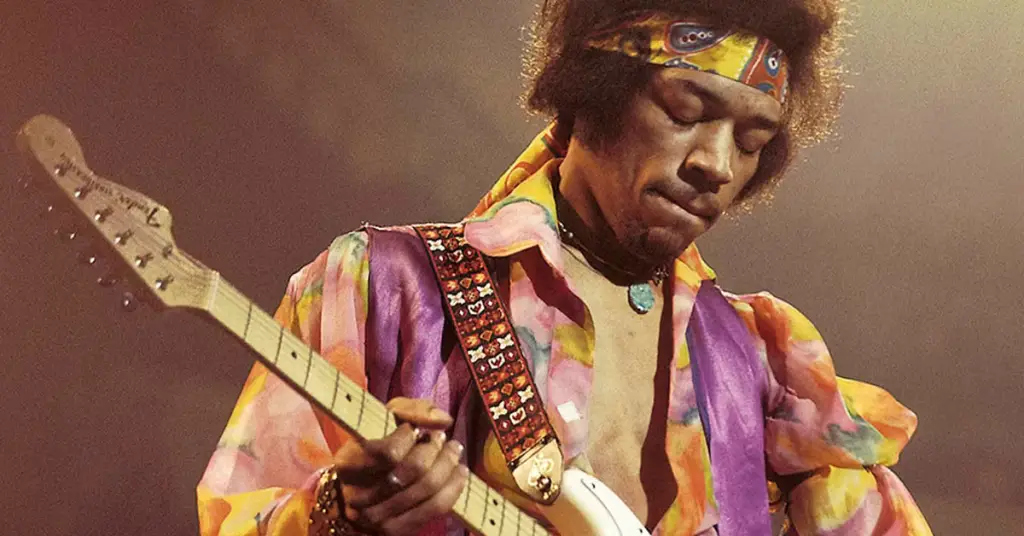Jimi Hendrix – “All Along the Watchtower”: A Sonic Storm That Redefined a Dylan Classic
When Jimi Hendrix picked up Bob Dylan’s cryptic folk song “All Along the Watchtower” in 1968, he didn’t just cover it—he shattered it, rebuilt it, and launched it into another dimension. With his version, Hendrix took Dylan’s parable-like lyrics and infused them with cosmic fire, turning a quiet acoustic tale into a thunderous, electric revelation.
In doing so, he created one of the most iconic and enduring rock recordings of all time—a track that even Dylan himself came to embrace as definitive. Hendrix’s “Watchtower” is more than a cover. It’s a transformation, and a prime example of what happens when a visionary artist reimagines a masterwork through their own singular lens.
The Origins: Dylan’s Mystery, Hendrix’s Vision
Bob Dylan first released “All Along the Watchtower” on his 1967 album John Wesley Harding, a stripped-down, folk-blues meditation filled with Biblical imagery and existential dread. The lyrics read like a riddle—dialogue between a joker and a thief, followed by ominous lines about princes, watchtowers, and gathering storms.
“There must be some way out of here,” said the joker to the thief…
Enter Jimi Hendrix. Upon hearing Dylan’s version, he recognized something burning beneath the surface. Hendrix took the skeletal structure and amplified its tension, its mystery, and its apocalyptic energy, wrapping it in waves of guitar and layered emotion.
The Sound: Electric Revelation
Recorded at Olympic Studios in London with the Experience—Mitch Mitchell on drums and Noel Redding on bass, plus guest contributions from Dave Mason and Brian Jones—Hendrix’s version of “All Along the Watchtower” is a three-minute sonic hurricane.
It opens with an urgent rhythm guitar line, then erupts with Hendrix’s unmistakable lead work—fluid, snarling, and crackling with distortion. The production is rich and layered, each guitar part swirling in and out like smoke. The drums crash and tumble, the bass throbs, and Hendrix’s voice—confident, cool, prophetic—delivers the lyrics with a gravity that feels almost divine.
“Businessmen, they drink my wine / Plowmen dig my earth…”
Every phrase sounds like it’s being carved into stone. And the guitar solos, which Hendrix weaves between verses like a second voice, are nothing short of transcendent—both bluesy and futuristic, wild and precise, human and alien.
The Impact: Dylan Approves
Bob Dylan was so impressed by Hendrix’s version that he not only praised it—he adopted Hendrix’s arrangement in his own live performances from the 1970s onward.
Dylan once said of Hendrix:
“He played [my songs] the way I would have played them… if I were that good.”
High praise from the song’s original author—and a reflection of how Hendrix didn’t just cover the tune, but revealed a deeper layer of its meaning through his performance. His version has become the definitive take for many listeners and regularly tops lists of the greatest cover songs ever recorded.
Legacy: A Towering Monument in Rock History
“All Along the Watchtower” was released in September 1968 as a single and later appeared on Electric Ladyland, Hendrix’s final studio album with the Experience. It became his highest-charting single in the U.S., reaching #20 on the Billboard Hot 100.
Over the decades, it has remained a pillar of Hendrix’s legacy, regularly cited as one of the greatest guitar recordings of all time. It has influenced generations of guitarists, songwriters, and producers—and still sounds like a storm on the horizon.

Final Thoughts
Jimi Hendrix didn’t just reinterpret Bob Dylan’s “All Along the Watchtower”—he electrified its soul, revealing the fire and foreboding buried beneath its verses. With his visionary guitar work, spiritual intensity, and fearless creativity, Hendrix turned a whispered warning into a shouted prophecy.
A joker, a thief, a watchtower, and a coming storm.
In Hendrix’s hands, these weren’t just words—they were revelations.
And they still echo, loud and clear, more than 50 years later.
Thank You
We appreciate your time and dedication to reading our article. For more of the finest blues guitar music, make sure to follow our Facebook page, “I Love Blues Guitar”. We share exceptional selections every day. Thank you once again for your continued support and readership.


Facebook Comments